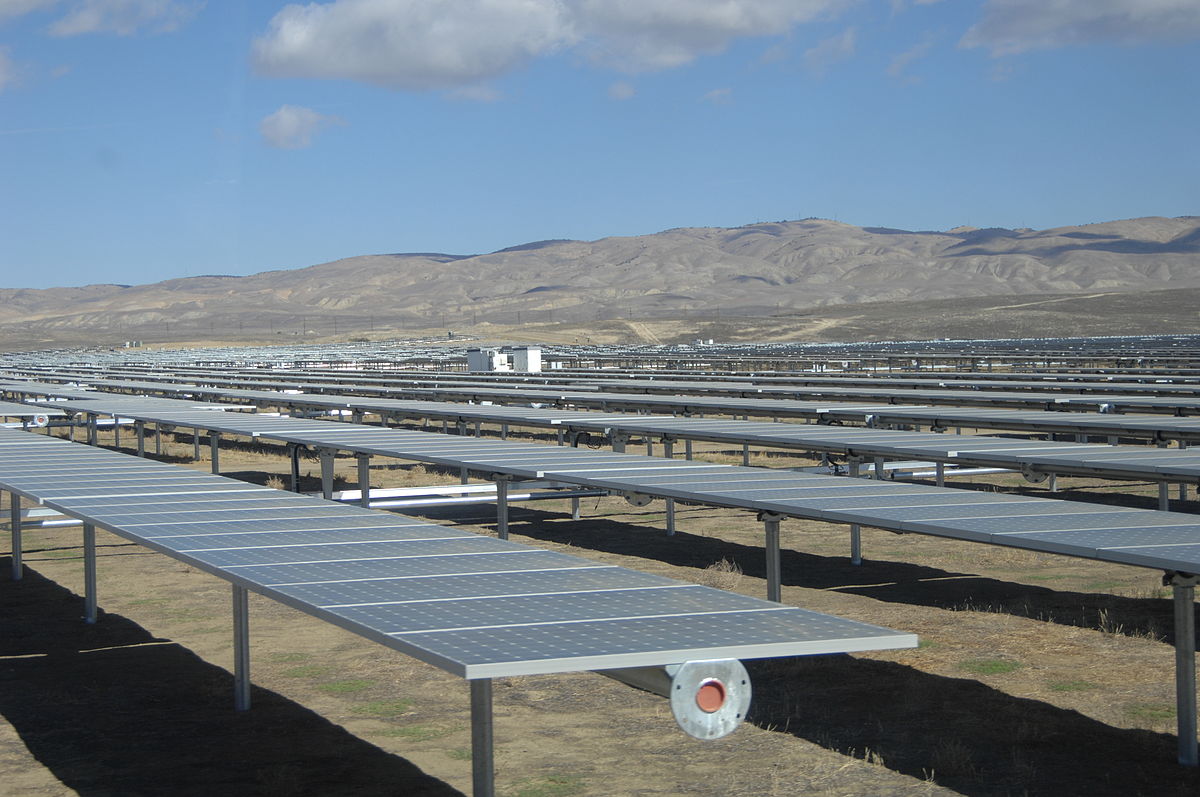This spring, Alameda County approved of the Aramis Renewable Energy Project, dividing East Bay environmentalists who disagree about whether the undeveloped North Livermore Valley should remain open ranchland and wildlife habitat, or whether part of the flat, sunny valley would be put to better use as a solar farm to help the Bay Area transition away from fossil fuels.
All around California, the development of open space to produce renewable energy has put climate and biodiversity goals at odds. To meet the state’s 2045 goal of 100 percent renewable energy will require between 1.6 and 3.1 million acres of wind and solar, according to projections from The Nature Conservancy, and much of that land, like the North Livermore Valley, has wildlife living on it. The debate has become acrimonious, framed as a choice between stopping the extinction of the desert tortoise or the extreme heat killing people in the Pacific Northwest.
But some scientists and activists say there’s another way: the deployment of distributed solar systems, such as those on rooftops and over parking lots. After federally threatened desert tortoises died as a result of the Yellow Pine Solar Project in the Mojave Desert, Kevin Emmerich, co-founder of Basin and Range Watch, wrote, “Does using renewable energy mean we have to push species toward extinction? No, these solar panels can easily go on rooftops and brownfields.” Already over a million homes in California have rooftop panels, and more residential rooftop solar is installed here each year than any other state by far.
Not only is sunshine an abundant resource in California, but “the rooftop itself is also kind of an abundant resource if you want to think of it that way,” says Bernadette Del Chiaro, executive director of California Solar & Storage Association, a trade group for distributed solar businesses. She points to a 2016 report from the National Renewable Energy Laboratory that estimated that 74 percent of all electricity sold in California in 2013 could be generated by rooftop solar. “[The report] found that we could go easily seven times the amount of rooftop solar as we have today. We have about 10 GW of rooftop solar [now], and we could get to 70 GW if we really just maxed out on rooftop space and parking lot space.”
Google’s Project Sunroof shows that in the Bay Area, millions of roofs could host a lot of solar capacity. In San José, 97 percent of roofs are viable for solar panels, according to the mapping tool, which could theoretically provide California with 4.4 GW of capacity. Even in foggy San Francisco, 84 percent of rooftops are suitable for solar panels, which could add 1.6 GW of solar capacity and bring California that much closer to its 100 percent clean energy goals.
Daniel Kammen, a professor of energy at UC Berkeley with parallel appointments in the Energy and Resources Group, Goldman School of Public Policy, and department of Nuclear Engineering, says that getting solar panels on every viable roof in California is “certainly a realistic potential, a realistic goal. The potential is huge.”

But even if California takes advantage of every viable rooftop and parking lot, it still wouldn’t be a silver bullet. Distributed solar must be supplemented with some utility-scale solar and wind projects, Kammen says. Not every rooftop in California gets enough sunlight for solar panels to be viable, plus, of course, solar panels only generate energy when the sun is shining.
Distributed systems also need to be paired with batteries to store energy after the sun goes down, especially since electricity demand is also expected to increase significantly in the coming years as the state and the nation look to electrify housing and transportation sectors. Furthermore, says UC Berkeley professor Severin Borenstein, the chair of the Energy Institute at Haas School of Business, some customers, such as industrial or commercial properties, don’t have enough rooftop space to generate all the energy they use.
“[Rooftop solar] can’t do it all, but it can do a lot,” says Del Chiaro. “And it can do a lot more than what we’ve done so far.”
A July 2021 report from Environment California Research and Policy Center estimates that each gigawatt (GW) of rooftop solar that is deployed in place of one GW of utility-scale solar “potentially avoids the conversion of almost 5,200 acres of land, an area slightly smaller than the city of Monterey.” And since state officials expect that California will need to increase its current rooftop solar capacity from 10.5 GW to 39 GW by 2045, rooftop solar might spare 148,000 acres of land in California as the state transitions to 100 percent clean energy.
That means that in the most optimistic scenario, in which California “maxes out on solar,” adding another 60 GW of distributed solar in the next 24 years in place of utility-scale solar farms, more than 300,000 acres could be spared — theoretically. But rooftop solar is not without its own issues and disadvantages.
Conservationists who dismiss large-scale solar farms as unnecessary overestimate the value of rooftop solar in California, Borenstein says. “I think rooftop solar has a role to play, [but] I don’t think it’s as large as many people in California do.”
That’s partly because he says rooftop panels are less efficient than utility-scale solar farms. Utility-scale solar facilities typically use trackers, which tilt throughout the day to follow the sun, maximizing sun exposure and extending the length of a production day. Borenstein says that although utility-scale solar projects lose some of that total energy to “line losses”– which happens during transmission as the energy travels from the solar farm to homes and businesses — on the whole, utility-scale solar projects are still more efficient than rooftop systems.
It also just costs more, Borenstein says. “We could do a lot more rooftop solar, but it would just raise the cost of decarbonization substantially,” he says. “It is much, much more expensive than grid-scale solar.”
Net metering, a policy that has been credited with helping drive rooftop solar adoption in the state, allows solar households to be billed for only the net energy that they use. So, a solar customer who generates more electricity than they use during the daylight hours shares that energy to the grid, offsetting the cost of the energy they’ll need to use at night.
The problem, Borenstein says, isn’t net metering itself; it’s that solar households bypass their share of the system’s costs by producing their own electricity. “If you’re a PG&E customer and you put in rooftop solar, you avoid paying somewhere between 25 and 30 cents per KWhr for each KWhr your panels produce because you don’t have to pay PG&E that much for the power. But PG&E doesn’t save 25 to 30 cents, PGE saves 6 or 8 cents by not having to provide the power to you,” Borenstein says.
That’s because the majority of the price of electricity is made up of fixed costs, including things like transmission infrastructure construction and maintenance, wildfire mitigation and compensation, and subsidies for low-income ratepayers and energy efficiency programs — not the actual cost of providing energy.
“[Solar households] are still using the grid every second of the day because they are always either importing power or exporting power, but they are not paying for the grid or any of the other programs that are being paid for through electricity prices,” he says. The resulting issue, he says, is a cost-shift to non-solar ratepayers, who tend to be lower income and/or households of color. “The difference is a revenue shortfall that somehow has to be made up, and the way it’s being made up is they raise the rates on everyone else.”
California’s electricity rates are historically and nationally high, with PG&E’s rates about 80 percent higher than the national average. Although that’s mostly due to those high fixed costs, the Natural Resources Defense Council reports that low-income Californians “could save around $80 to $100 a year if we didn’t overpay for rooftop solar” under the current net metering policy.
Del Chiaro disagrees with the idea that rooftop solar is more expensive for California than utility-scale projects. A large part of our electricity rates go to transmission and distribution, she says, which means constructing and maintaining the poles and wires that deliver electricity — which also takes a toll on California’s ecosystems. “If we build more distributed clean energy, more solar and batteries, we can reduce the costs associated with delivering energy to our homes, and we can lower overall energy costs as a result,” she says. “Investing in distributed and small-scale projects that fit within our built environment, investing in those saves all ratepayers money.”
In addition to limiting development and saving ratepayers money, Del Chiaro says, distributed solar is safer since those high-voltage transmission lines that stretch across California’s dry landscape all-too-frequently spark wildfires, as well as more reliable because local energy generation “is just inherently more reliable and resilient.” In early July, the Bootleg Fire in southern Oregon encroached on transmission lines used to import electricity to California, prompting California’s grid operators to issue an urgent call to the public to conserve energy on Saturday evening to avoid rolling blackouts statewide.
However, few Californians will install solar panels on their roofs if it is more expensive to do it than to not do it.
This spring, California Assembly members Wendy Carillo and Lorena Gonzalez proposed a law, AB 1139, to reduce the credit to solar households for the extra energy they provide to the grid and to significantly increase the monthly fee they pay to help cover more of PG&E’s fixed costs, in a push to ease the cost burden of high electricity rates on non-solar households.
De Chiaro’s organization, the California Solar and Storage Association, maintained the bill “would basically kill the rooftop solar market.”
“There’s basically only two policies in place that help the economics of rooftop solar pencil out for homeowners, or business, or school,” De Chiaro says. “One is the Federal Investment Tax Credit, which is a 26 percent reduction in the upfront cost of your solar system,” and the other is net metering. “Without the investment tax credit, a lot of people won’t go solar because it just won’t pencil out for them, but without net metering no one will go solar.”

California Valley Solar Ranch, a 250 MW solar farm located on nearly 2,000 acres of Carrizo Plain, a grassland valley in San Luis Obispo County home to 13 protected species. The developers SunPower and First Solar created a 19,000-acre reserve nearby to compensate for the destruction of habitat. (Photo by Sarah Swenty/USFWS)
Concerns about equity and accessibility are front and center in discussions about distributed solar for both critics and advocates of net metering. Some, including Borenstein, who published a report earlier this year concluding that net metering hurts low-income Californians, argue that California’s transition to renewable energy would be more just with less distributed solar. Meanwhile others, including Del Chiaro and Kammen, argue the opposite.
Although the average incomes of solar adopters are higher than those of the general population, a report published earlier this year by Berkeley Lab’s Electricity Markets & Policy department shows that the share of solar adopters who were low- and middle-income grew significantly from 2010 to 2018. Del Chiaro says this is evidence that the current system is working, and in order to continue making progress on equity and accessibility, “we need to bring prices down, remove barriers, and give people a financial incentive to go solar.”
Kammen says that he believes restricting solar would be a “huge mistake” for California. “What we really want to do is encourage and incentivize solar plus storage,” he says. California policymakers need to prioritize the deployment of rooftop solar and storage in low-income and frontline communities, he says, “to really spread the benefits and to build larger and larger integration into the areas that typically have the worst service.”
Though the reform bill failed, the California Public Utilities Commission had already been considering other changes to net metering and will continue to do so in the coming months. One factor that the agency may not be considering, however, is the value of habitat and open space.
The CPUC uses a tool called the Avoided Cost Calculator to help guide their decision-making on whether or not to implement changes to net metering. “And in that calculator, as you might imagine, they do not assign a financial value to open space or to wildlife or to endangered species preservation,” Del Chiaro says. “Those are things that are very hard to quantify but they also, frankly, are not the priority of an agency whose purview is simply to regulate utilities.”
“I would encourage anyone who cares about open space and wants to take action to protect it, and who cares about climate change and understands that we need to both preserve open space and aggressively decarbonize, they should get involved with our campaign to save California solar,” she says.
The NRDC has proposed a plan for reforming net metering that seeks to balance these concerns by compensating solar households for the avoided cost to the utility — rather than the retail price — of the extra energy they produce. The group argues that the reform would incentivize household battery installation as well as encourage the continued adoption of rooftop systems by offering an up-front incentive for solar customers to make back their investment in distributed solar within 10 years.
If distributed solar is protected and prioritized in California, large-scale solar farms will have a smaller footprint on California’s open space. But even then, there is most likely no renewable energy future that doesn’t include a significant amount of utility-scale solar and wind projects. “If we only ramped up solar and storage, that would be great, but that wouldn’t see us through cloudy weeks in November,” Kammen says. “We need diversification into on-shore wind and off-shore wind as part of the deal too,” as well as solar facilities, both large and small, that have community solar programs.
Efforts to complete least-conflict mapping can help limit the negative impact of large-scale renewable energy projects by bringing together stakeholders, including environmental groups and Indigenous tribes, to identify the lands most suitable for renewable energy development, such as brownfields or low-productivity agricultural lands. Then, it’s up to regions, counties, and cities to create policies that encourage renewable energy in locations that will have the smallest impact on landscapes and ecosystems.
Severin Borenstein recalls a recent proposal to put solar panels on the parking lot of the BART station in Orinda, where he lives. “One of the complaints was: if we have these shaded parking spaces that have solar panels, well, solar panels reflect, and it’s gonna cause a lot of glare up into the hills where people live,” he says. “And it’s true! There is no energy source that doesn’t have some impact on people or the environment. I think we have to think carefully about what those tradeoffs are and what the costs are.”





